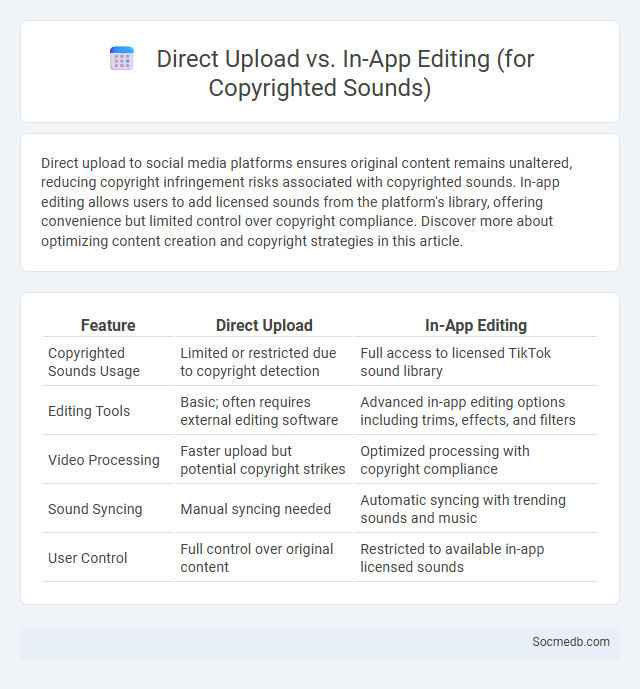
Photo illustration: Direct Upload vs In-App Editing (for copyrighted sounds)
Direct upload to social media platforms ensures original content remains unaltered, reducing copyright infringement risks associated with copyrighted sounds. In-app editing allows users to add licensed sounds from the platform's library, offering convenience but limited control over copyright compliance. Discover more about optimizing content creation and copyright strategies in this article.
Table of Comparison
| Feature | Direct Upload | In-App Editing |
|---|---|---|
| Copyrighted Sounds Usage | Limited or restricted due to copyright detection | Full access to licensed TikTok sound library |
| Editing Tools | Basic; often requires external editing software | Advanced in-app editing options including trims, effects, and filters |
| Video Processing | Faster upload but potential copyright strikes | Optimized processing with copyright compliance |
| Sound Syncing | Manual syncing needed | Automatic syncing with trending sounds and music |
| User Control | Full control over original content | Restricted to available in-app licensed sounds |
Introduction to Audio Content and Copyright Challenges
Audio content on social media platforms encompasses podcasts, music clips, voice notes, and sound bites, which significantly enhance user engagement and content diversity. Copyright challenges arise as unauthorized use of copyrighted audio can lead to legal disputes, content takedowns, and monetization issues due to platform policies and digital rights management. Platforms like YouTube, Instagram, and TikTok employ automated content identification systems to detect and manage copyright infringements, ensuring creators' rights are protected while maintaining community standards.
Understanding Direct Upload of Copyrighted Sounds
Direct upload of copyrighted sounds on social media platforms involves sharing audio content without obtaining proper licenses, which increases the risk of copyright infringement claims. Platforms like Instagram, TikTok, and YouTube use automated content identification systems such as Content ID to detect unauthorized use of copyrighted music. To protect your account and avoid legal issues, ensure you have permission or use royalty-free audio when uploading sound directly.
The Role of In-App Editing for Copyrighted Audio
In-app editing tools play a crucial role in managing copyrighted audio on social media platforms by enabling users to trim, mute, or replace clips within allowed guidelines, reducing the risk of infringement. These features help You customize audio content while adhering to platform-specific copyright regulations and licensing agreements. Efficient in-app editing supports content creators in maintaining compliance and amplifying their reach without legal complications.
Sound Copyright: Key Concepts and Legal Framework
Sound copyright protects original audio recordings, including music, voiceovers, and sound effects, under laws such as the Copyright Act and international treaties like the Berne Convention. Your use of social media content must respect these rights by obtaining licenses or permissions to avoid infringement claims and potential penalties. Understanding fair use exceptions and content identification technologies ensures your compliance while sharing or creating audio-based posts.
Direct Upload: Pros, Cons, and Compliance Concerns
Direct upload on social media platforms streamlines content sharing by allowing you to post images, videos, and documents instantly without third-party tools, enhancing user convenience and engagement. However, this method may pose challenges such as limited file size, format restrictions, and potential security risks, requiring careful management to avoid compromised data or poor-quality posts. Ensuring compliance with platform policies and data protection regulations is crucial to protect your account integrity and maintain trust with your audience.
In-App Editing: Benefits, Limitations, and Legal Safeguards
In-app editing on social media platforms offers you immediate convenience by enabling quick photo and video adjustments without switching apps, enhancing your content's visual appeal. However, limitations include restricted editing features compared to dedicated software and potential quality loss during processing. Legal safeguards protect user-generated content from unauthorized alterations and ensure compliance with intellectual property rights to prevent misuse.
Comparing Direct Upload vs In-App Editing for Copyrighted Sounds
Direct uploads ensure the original audio quality and copyright metadata remain intact, providing better protection against unauthorized use and easier rights management. In-app editing often compresses or alters the sound file, potentially complicating copyright claims and reducing audio fidelity. Choosing direct upload is optimal for creators prioritizing legal safeguarding of copyrighted sounds on social platforms.
Best Practices for Managing Sound Copyright in Apps
To effectively manage sound copyright in social media apps, ensure all audio content is properly licensed or sourced from royalty-free libraries to avoid legal issues. Implement robust content identification systems like digital fingerprinting or watermarking to detect unauthorized use of copyrighted sounds. You should also educate users on copyright policies and facilitate easy reporting of infringements to maintain compliance and protect creators' rights.
Legal Risks: Copyright Infringement in User-Generated Content
Social media platforms face significant legal risks due to copyright infringement from user-generated content, as unlicensed sharing of protected works can lead to costly lawsuits and statutory damages. Content creators, platform operators, and users must ensure proper licensing or fair use compliance to mitigate potential copyright violations. Implementing robust content monitoring and takedown procedures under the Digital Millennium Copyright Act (DMCA) is essential for platforms to limit liability.
Future Trends in Audio Content and Copyright Management
The future of social media is shaped by the rapid evolution of audio content, with advancements in voice-activated technologies and spatial audio enriching user engagement. Copyright management will increasingly rely on blockchain and AI-driven solutions to ensure transparent, real-time tracking and protection of intellectual property rights. Enhanced digital rights management systems will enable creators to monetize audio content more effectively and combat unauthorized use on global platforms.
 socmedb.com
socmedb.com